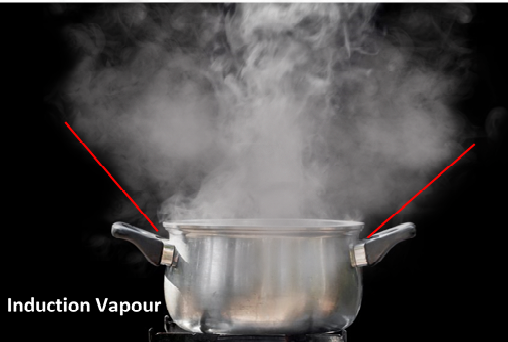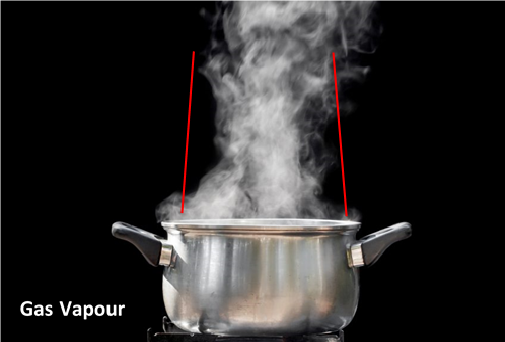Cooker Hoods Buying Guide

Whether you’re looking for a stylish designer piece or a practical cooker hood, this guide is here to explain the important points about cooker hoods and to help you choose the right model for your kitchen. We will look at extraction rates, ventilation type and some important issues about design.
Kitchen cooker hoods are appliances designed to be placed above a hob/Cooker to filter the air in your kitchen. They come as either ducted or recirculation models (more about both of those later) For many people a kitchen extractor is just an afterthought but not having adequate ventilation can lead to permanent damage to your kitchen as grease can stain your paint work and builds up in hard to clean places, as well as this odours linger in your home when sufficient ventilation is not installed.
Please note: That all extraction rates on our website are quoted as unrestricted rates, this means that once ducting / charcoal filters are added, your extraction rate will change depending on what size/ length of ducting you choose to install, each bend you add to your ducting will also reduce your extraction rate, therefore the best rule to use when choosing your ducting is to use the largest, shortest and straightest run possible to achieve the best extraction rate possible for your installation. Please note this also applies to DB readings for motors, these are quoted before installation.
It is impossible for us to predict what extraction rate you will achieve as every installation is different, there are so many variants of installation that we can only advise you an unrestricted motor reading.
Before choosing your cooker hood your should first work out the minimum extraction rate required for your kitchen area. To do this please follow the simple calculation below:
M³ Volume of kitchen (Length x Width x Height) then times this by 12. This is to allow for 12 recommended changes of air per hour.
Example: Your kitchen is 6 metres long, 3 metres wide and 2.5 metres high. Multiply the room’s length x width x height to get the cubic capacity: in this case 45m³. If you wanted 12 changes of air per hour, then the extraction rate required would be 12 x 45m³, which is 540m³. So any cooker hood you consider should have a minimum extraction rate of 540m³/hr.
Example:
6m x 3m x 2.5m = 45m³
45m³ x 12 = 540m³/hr
We highly recommend using a cooker hood with more than the minimum extraction rate required. We also highly recommend using 6" circular (or rectangular equivelent) ducting, this will allow for the highest extraction rate as you will not be restricting the airflow by using a smaller size ducting.
Most of the cooker hoods we sell can be set to either an extraction or a recirculation mode. Extraction should always be your preferred option, but here we look at the pros and cons of both types. Please take into account if you have an induction hob, we always recommend to duct out and not recirculate. We explain further about this later in the article under Essential information.
How extraction works:
Steam and odours are removed from the kitchen to the outside of your house via ducting.
Advantages:
- Removes airborne contamination – smoke, odours, etc - to the outside
- No need to replace charcoal filters on a regular basis, therefore making the long term running costs cheaper
- No charcoal filter in front of the motor means airflow rate and extraction is higher
Disdvantages:
- Some kitchens don’t allow for extraction due to a lack of space or capacity to install the ducting
- Additional initial costs, for example for ducting and installation
- Ventilation Explained - PDF File - Opens in a New Window
- Ducting Sizes Explained - PDF File - Opens in a New Window
A filter containing activated charcoal is used to remove odour and smoke from the air, before releasing the ‘scrubbed’ air back into the kitchen.
On any hood you install as recirculating you must have the vents on the chimney section showing and unrestricted to allow the air to come back into the room, if these are blocked or covered up then this will damage your
motor due to back pressure blowing back down the hood.
Benefits:
- Can be installed almost anywhere – ideal if you can’t reach an outside wall with ducting
- Cheaper installation costs as ducting is not required
Disdvantages:
- Recirculates some heat and moisture back into the kitchen
- Regular monthly replacement of charcoal filter is necessary, which raises running costs
- Decreased airflow rate up to 1/3 due to charcoal filter placement in front of motor, can increase noise levels
- You will tend to find not all odours will be collected by the charcoal filters and may linger for longer
- Not Recommended for Induction Hobs
When recirculating ceiling hoods, you must take into consideration how the air is going to be recirculated back into the room. For instance, when recirculating a wall hood you will have vents on either side of the chimney section that allow the "scrubbed" air to flow back into the kitchen.
This rule also applies to ceiling hoods, therefore not all ceiling hoods that are being installed this way can be fitted flush.
You have 2 options in which you can install a recirculating ceiling hood.
- To enable a flush fit you would need to consider how the air is going to come back into the room, one way is to run a short piece of ducting from the motor back into the room.
- Alternatively, you can install the hood in a drop down box from the ceiling and then install vents at either side to allow the air to recirculate.
Not doing this, and simply allowing the air to be ducting into a ceiling void/ Loft space can create smells in the room above, but more seriously it can create damp and moisture as the steam and warm air is being blown into that space with no ventilation.
Luxair now have a NEW range of ceiling hoods that are specifically designed to be recirculated that simply secure to your ceiling and connect to a power supply see our NEW STRATOS RANGE - HERE
If air is being recirculated through the cooker hood for release back into your kitchen, it is taken through two filters: a grease filter and a charcoal filter.
All cooker hoods come supplied with a grease filter, but not a charcoal one; these can be obtained through the product page as an optional extra or there is dedicated spares and accessories section on our website.
The charcoal filter needs to be replaced every 2-3 months or every 50 hours of cooking whichever comes first, depending on how often you use your cooker hood.
The metal grease filter can either be replaced, or washed - usually in the dishwasher - if it is a permanent metal filter.
In order to maintain the motor and keep it in good conditon, we recommend to clean you metal grease filter on a monthly basis, if using charcoal filters they must be replaced every 2-3 months, by not doing this a build up of grease can solidify on the motor blades and cause your motor to malfunction over time. by cleaning/replacing the filters regulrly this will help maintain the motors life.
Ducting kits aren’t supplied with our cooker hoods and can be obtained directly from the product pages or the spares and accessories section on our website. Alternatively, generic ducting is available from all good DIY stores.
We Specify that a minimum of 5" (125mm) round ducting must be used on ALL our hoods unless stated otherwise however we do recommend the larger 150mm ducting if your builder gives you the go ahead – this will offer a slightly improved airflow rate, since the ducting is a bit wider, and reduce vibration as the airflow is increaced. The hole in the wall MUST be increased to the same size as the ducting being used, if it is smaller you must not push a 5" ducting hose through a 4" hole in the wall.
If you are using flat ducting instead of round then the equivelent size for 5" = 150mm x 75mm 6" = 180mm x 95mm
Installing any of our hoods on smaller ducting will invalidate your warranty as this overtime will damage your motor due to restricted airflow.
Rigid ducting will also offer improved airflow and less noise over flexible ducting. This is because flexible ducting – even when pulled fairly taut – has ridges that slightly inhibit the flow of the exhaust air.
Please also install with the minimal amount of bends in your ducting run as possible as this each bend will reduce the extraction rate by 1/3.
Please note extraction rates quoted on our products are unrestricated, once ducting is added plus any bends your output will reduce, please take into account the longer the ducting and more bends added the less extraction you will receive.
The larger the duct, with the shortest and straighest run as possible will achieve the best extraction results.
The noise of the hood can be somewhat intrusive when on intensive or high speed, Stud walls will always be noiser than if installed on an outside wall due to the hollowness of the wall itself, therefore vibration will make the unit noisier than normal, to reduce this we recommend to use larger ducting if possible (6").
Please also note that, your builder may have used the recommended 5"-6" ducting however we often find that the hole in the wall as not been increased to the same size as the ducting and has been left as a 4" hole. This MUST be increased to either the same size or larger than your ducting that is being used as not doing so will effectively mean that your hood is running on 4" ducting, and will cause vibration and back preassure on the motor. If you find this is the case please Stop using your hood and increase the hole in the wall as soon as possible as continueing to use your hood on 4" will damage the motor.
The larger the ducting used, the less vibration meaning the fan will be less noisey then if on a smaller ducting.
Even taking all this into consideration, sometimes the acoustics of the room itslef does have bearing on the noise level being heard.
A good tip, especially if you're eating in the kitchen, is to switch the hood on a few minutes before you start cooking to get air circulating in advance. You can then switch it off or to the lowest setting when you sit down to eat, and it will have done its job.
Induction Hobs
 |
 |
If you have an induction hob, then buying an extractor is slightly different than if you have a Gas or Electric hob.
Due to induction hobs not generating any heat by thermal conduction from a flame or an electrical heating element, the steam that is generated in the pan disperses differently.
When using a hob with a flame/heating element, this helps the steam rise from the pan quickly before it turns from steam to water and is extracted before this process happens, the heat also warms up the hood at the same time meaning less chance of condensation collecting,as the warm air is not hitting a cold surface turning it into water.
As induction Hobs do not work in this way and are electromagnetic, this means they do not generate direct heat and the steam that is being generated in the pan is slowly rising and dispersing immediately rather than being forced up, and warming up the extractor at the same time.
Because of this, this often causes significant condensation and is something that unfortunately cannot be avoided as the steam is often already turning into water as it cools down when rising.
When buying a cooker hood with an induction hob we always recommend to buy x2 sizes larger than the hob, for example if your induction hob is 60cm then we advise to buy an extractor with at least an extraction area of 80cm (this does not include certain products where the glass is 80cm and the body's extraction area only being 60cm ) as this will help collect the steam better that disperses around the sides of the hood from the pan, before it turns into condensation.
Recirculating & Angled hoods are not recommended for Induction hobs due to the humidity / moisture caused by the hob.
If condensation occurs it is advised to leave the hood running for at least 20 miiutes afterwards and the excess moisture will need to be removed by additional airing which will lead to loss of heat.
Wall Mounted Canopy /Island Hoods
You'll need to position the hood at a minimum of 750mm above a gas hob, or 650mm above an electric hob.
This is different for Angled hoods and the position changes to 500mm for either gas or electric.
When purchasing a cooker hood you will need to make sure the size of the extractor is either the same size or larger than your hob to avoid steam escaping around the edges when on the lower settings.
When installing wall mounted hoods with glass you must allow a 3-4mm gap between the hood and any cupboards/ hob that may be at either side, this will allow the expansion and contraction of the glass during the heating and cooling process when cooking
and will ensure your glass does not crack or shatter........
Please also remember not to tighten any screws that hold the glass in place too tightly to avoid the same situation.
Ceiling Hoods
For ceiling hoods we recommend not to install any further than 1.5 - 2m away from your hob for best results, take into consideration the closer to your hob the better the extraction.
We also advise you to duct the shortest route possible and on the largest ducting that will allow.
Please also install with the minimal amount of bends in your ducting run as possible as this each bend will reduce the extraction rate.
Downdraft Extractors
These extractors will work with either Gas/electric or induction hobs and can be installed a few millimetres away from your hob but recommend no more than 200mm for best results.
Glass Splashbacks
All of the Luxair splashbacks should be installed with Clear mirror adhesive and not a white silicon based glue as this can tend to show through the paint once it has dried.
You must allow a 2-3mm gap between the splashback and any cupboards that may be at either side, this will allow the expansion and contraction of the glass during the heating and cooling process when cooking and will ensure your splashback does not crack or shatter.
Hobs should be installed a minimum of 2cm away from your splashback so there is no direct heat from the back burners.
All our Glass is made from toughened glass and is designed to shatter into small pieces rather than shards if the above ever happens due to incorrect installation.
If a drawer is installed underneath the hob, when in use, the drawer can warm up to 60°C. This is not a malfunction.
